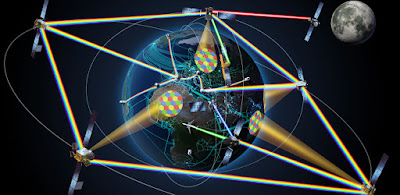Free Space Optics Communication: Enabling Faster Wireless Communication Networks Over Short Distances

Free Space Optics Communication
Introduction to FSO Technology
Free space optics (FSO) refers to an optical communication technology that uses light propagating in free space to transmit data wirelessly. FSO communication utilizes lasers or infrared LEDs to transmit data at infrared or visible wavelengths through free space. Like fiber optics, FSO uses beams of light to transmit information-encoded data streams. But unlike fiber optics which relies on cables, free space optics transmits through open space.How FSO Works
In an FSO system, data is encoded as infrared laser beams or pulses. A semiconductor laser at the transmitter side converts an electrical data signal into a modulated light beam. This light beam propagates through the free space medium and is collected at the receiver side by a telescope. The telescope focuses the incoming light onto a photodiode detector. The photodiode converts the received light signal back into an electrical signal which can then be decoded to extract the original data.
Key Components of an FSO System
The main components of an Free Space Optics Communication system include a laser diode or LED transmitter, a collimator lens, a telescope receiver and a photodetector. The transmitter emits infrared light beams which are collimated or made parallel using a lens. This collimated beam propagates through free space and is collected by the receiver telescope. The telescope focuses the received light onto a photodetector. Common photodetectors used are positive-intrinsic-negative (PIN) photodiodes and avalanche photodiodes (APDs).
Applications and Advantages of FSO Communication
FSO has several advantages compared to conventional wireless communication technologies like Wi-Fi or cellular networks. Some key applications and advantages of FSO include:
Last Mile Connectivity: FSO is well-suited for providing high-speed last mile connectivity to homes and businesses located in remote, rural or isolated areas where fiber infrastructure is difficult or costly to deploy. With a range of 1-5 km, FSO bridges the last mile connectivity gap more cost effectively than other technologies.
Enterprise and Campus Connectivity: Many businesses, universities and organizations use FSO links to connect buildings within their campuses and establish private high-speed networks. FSO networks offer fiber-like speeds without the hassle and cost of laying fiber cables across campuses.
Oil Rigs and Ships: FSO links are widely adopted to provide network connectivity between offshore oil rigs and between ships. The mobility offered by FSO systems allows establishing on-the-go networks on moving vessels.
Disaster Recovery: FSO provides a versatile wireless connectivity solution in disaster recovery situations where conventional wired networks may be damaged. FSO networks can be rapidly deployed to restore communications.
License-Free Operation: FSO spectrum in the infrared range is unregulated worldwide so no licensing is required for deployment. This is unlike wireless technologies operating at radio frequencies.
High Bandwidth Capacity: With multi-gigabit capacity, FSO links support bandwidth-hungry applications. Speeds nearing 10 Gbps are possible today with point-to-point FSO links.
Security: Since light beams are highly directional, FSO links offer a natural level of physical security against eavesdropping compared to radio wireless networks.
Lower Operational Cost: FSO systems are inexpensive to install, operate and maintain compared to laying and maintaining fiber cables. This makes long term operational costs very low.
Challenges and Limitations of FSO Communication
While FSO has many advantages, there are some challenges and limitations:
Propagation Losses: Fog, rain, snow can attenuate or scatter the light beams making signal reception difficult in adverse weather. Mitigation using adaptive optics is an area of active research.
Misalignment Losses: Vibrations and thermal fluctuations can cause the transmitter and receiver to get misaligned leading to signal losses. Active tracking systems are required.
Eye Safety: High power lasers pose eye safety issues if the beam hits a person accidentally. Regulations on maximum permissible exposure limits must be followed.
Range Limitations: Compared to radio networks, FSO has a shorter range of 1-5 km depending on weather conditions. Relays may be needed for longer distances.
Interference Issues: Bright light sources like sunlight or car headlights in the path can potentially interfere with reception of the light communication signal.
Future Outlook and Research Directions
The future of free space optics looks promising as research advances technologies to overcome current limitations and expand applications. Some directions gaining focus include:
- Development of advanced adaptive optics to mitigate effects of atmospheric losses and ensure reliable operation in all weather conditions.
- Use of multiple wavelengths or mixed RF-FSO for increased reliability under adverse weather and obstacles in the path.
- Miniaturization of components through photonic integration for portable and cost-effective systems.
- Standards development for interoperability of equipment from different vendors.
- Hybrid FSO-fiber networks for extending ranges beyond current limitations using fiber cable backhaul.
- Integration of FSO capabilities into unmanned aerial vehicles (UAVs) and flying drones for temporary and on-demand networks.
- Application of machine learning in FSO receivers for improved signal processing under dynamic conditions.
With rapid advances, FSO is expected to become a mainstream wireless alternative offering multi-gigabit connectivity over short distances, complementing and enhancing the capabilities of existing communication networks. Its inherent security features will also increase its adoption across commercial and strategic sectors.
Get More Insights on Free Space Optics Communication



Comments
Post a Comment